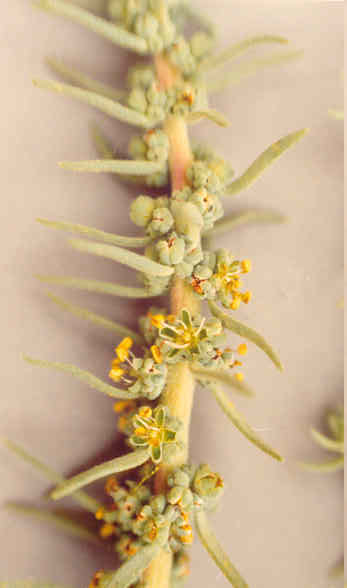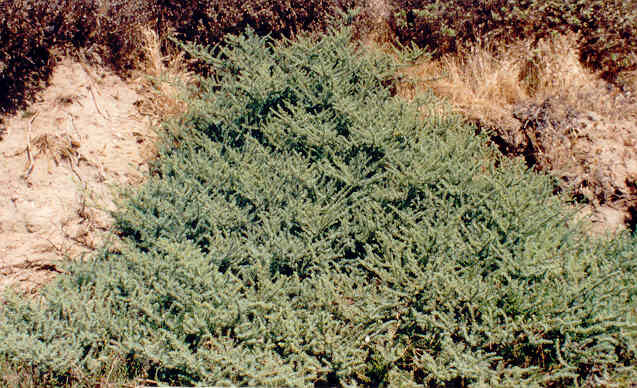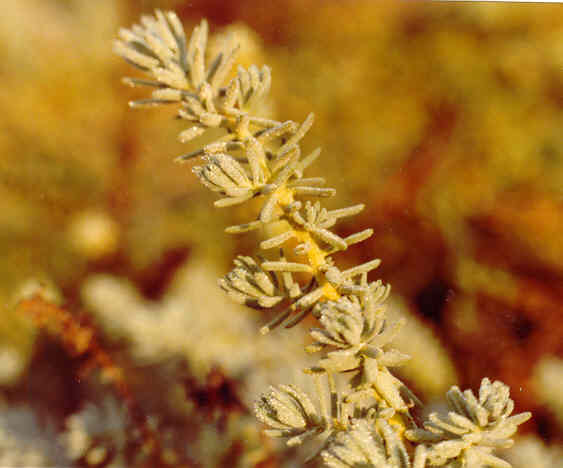
Suaeda taxifolia (Standley) Standley
=Suaeda californica var. pubescens
Chenopodiaceae (Goosefoot
Family)
Native
 |
Suaeda taxifolia (Standley) Standley=Suaeda californica var. pubescensChenopodiaceae (Goosefoot
Family)
Native
Woolly Sea-BlightSea-Blite |
May Photo
Plant Characteristics:
Glaucous, densely pubescent, suffrutescent perennial, the stems ascending
or decumbent, stout, 3-8 dm. long; lvs. many, alternate, rather crowded,
spreading, subterete, 3-10 cm. long, not much reduced in infl.; fls. 1-1.5 mm.
wide, glomerate in the lf. axils; calyx 5-lobed, cleft halfway, not appendaged,
glaucous; seed black, shining, 1.5-2 mm. broad, horizontal or vertical.
Habitat:
Coastal Salt Marsh; Ventura co. to San Diego. Below 15 m. July-Oct.
Name:
Suaeda is an Arabic name of
antiquity. Californica indicates that the species was first found in
California. (Dale 13,98).
L. pubescens, with hairs of
puberty. (Jaeger 213).
Gr. taxo, to put in order, arrange.
Taxifolia, possibly referring
to the orderly alternate leaves. (my
comment)
General:
Common in the study area.
Photographed at North Star Beach and Big Canyon.
In Upper Newport Bay, most plants of this species are found above the
line of highest tide or with only the skirt of the plant in the water at highest
tide. At least a few plants,
however, occur within the tidal zone and these are found along the path between
Delhi and 23rd St. (my comments).
The common name "blite" has been applied to many members of the
Goosefoot Family for centuries. It
is not at all kin to the English word "blight."
Instead it means "insipid" in Latin and indicates that few of
these plants are tasty. The Indians
used the seeds along with many others for a mush called pinole. Those who have
duplicated this dish assert that it is indeed insipid.
The plant made a rich, black dye for the weaving of Indian baskets.
(Dale 98). Cahuilla
Indians, inhabitants of the Colorado Desert, the San Jacinto and San Bernardino
Mountains, used the seeds and leaves for food.
Baskets were dyed with Suaeda
coloring. Upper tender stems,
leaves and flowers are all pleasant when cooked.
Some species are very salty and require rinsing in a change of water or
boiling for 5 minutes to make them palatable.
(Clarke 168,169).
The Indians made a rich black dye from the plant for coloring the
strands, which they used in making the patterns in their colored baskets.
The whole plant was steeped in water and the dye obtained was said to
have been very penetrating and durable with a fetid and disagreeable odor.
The leaves were gathered, boiled and eaten as greens.
In the early days at San Diego, the plant was known as Glasswort because
of the
glassy brittleness of the stem. Gathered
in large quantities, the plants were burned and the ashes used in making soap.
(Balls 81).
Sea-blite, Suaeda taxifolia, is a short-lived perennial, which does not spread
vegetatively. Seedlings of this
species are common at Tijuana Estuary. Its
ability to establish from seed allows sea-blite to invade bare intertidal soils,
but prevents it from forming dense stands in an otherwise vegetatively
reproducing marsh vegetation. (Zedler
26). More
than 70% of the species will be found between 5.6 and 6.2 ft. above MLLW.
(Zedler 17).
Suaeda taxifolia
is one of the native halophytes occurring in Upper Newport Bay.
See Spartina foliosa for a complete list of the halophytes.
See Suaeda esteroa for
additional information on the Suaedas. (my comments).
About 50 species of wide distribution.
(Munz, Flora So. Calif. 369).
Text Ref:
Collins 181; Munz, Calif. Flora
384; Munz, Flora So. Calif. 369;
Roberts 19.
Photo Ref:
Dec 2 82 # 3,4; May 5 83 # 8; June-July 93 # 2.
Identity: by R. De Ruff.
First Found: December 1982.
Computer Ref: Plant Data 229
Have plant specimen.
Last edit 6/7/04.
 |
 |
May Photo December Photo